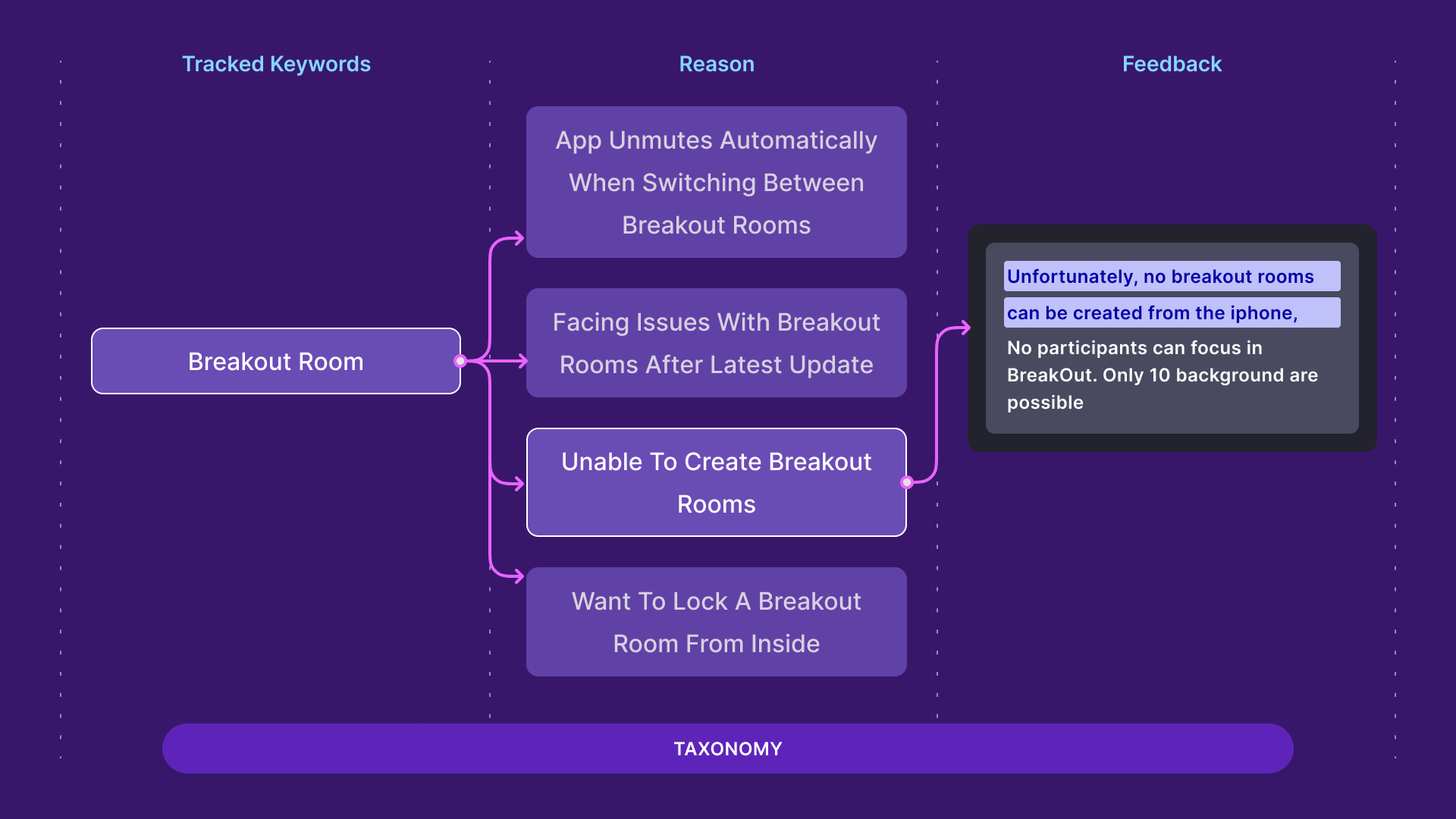
Your qualitative feedback is abstract and hard to quantify. Here’s how you fix it.
You’re going through customer feedback to manually tag it. One customer tweets, “The music stops and cuts off every time I put my headphones on.” Another customer reviews your app and says, “Every time I hit play after updating my playlist, the app quits randomly and restarts.”
Feedback like this is pouring in for all products from multiple channels. If you interpret or group customer feedback incorrectly, or you’re too slow to act on it, you risk user churn and revenue. That’s how high the stakes are.
Qualitative feedback is notoriously difficult for product teams to interpret and act on because it’s subjective, nuanced, and time consuming. To actively listen to what customers are telling you, you have to be able to aggregate their feedback across all relevant sources, unify your feedback taxonomy, and analyze it granularly to pull valuable insights. A process that’s too broad or manual will not only end up being a colossal waste of time, but also do more harm than good by signaling you to invest in the wrong areas.
What is qualitative feedback?
Qualitative customer feedback is made up of in-depth, open-ended responses, as opposed to relying on singular, static data points. Customers often expand on their user experience or motivations when they’re giving qualitative feedback, helping you dive deeper into user behavior and needs.
Qualitative feedback can come in many forms, such as:
- Text responses in Net Promoter Score (NPS) surveys
- Conversations with support agents
- Help requests on social media
- App store reviews
Customers might say just a few words or write multiple paragraphs, but they’ll go beyond the what of quantitative data and explain the why. A quantitative CSAT score provides a numerical measure of customer satisfaction, but qualitative data explains why customers are giving you that score.
There’s inherent value in making sense of qualitative feedback because you can make more informed decisions. In one experiment, using qualitative insights led to a 300% lift in conversion rates.
Unlike quantitative feedback, qualitative feedback is notoriously abstract and difficult to analyze
Quantitative feedback allows you to look into the numerical data and pinpoint exactly what’s driving user behaviors, like clicks, subscriptions, and customer attrition. But qualitative feedback is more subjective and situational. It can’t be wrangled so confidently. You have to understand what your customers’ feedback means collectively, not just what they’re saying syntactically.
Take these two examples of customer feedback. Both customers were having issues with Shopify’s global payments but used different language to explain the problem and request a new feature.
This makes the feedback highly subjective for teams to analyze, which introduces biases to the decision-making process. Product teams start thinking, “We got a lot of comments about dark mode last week. Let’s roll out an update.” But they might not realize they’re getting a higher volume of requests for global payment support because they all use different language. Instead of being able to objectively quantify requests over time, recency bias takes precedence.
Without proper validation or efficient tagging, teams can’t neutrally analyze the feedback they’re getting. Different team members or departments may interpret or prioritize them differently based on language and other factors. And if companies received hundreds of these types of feedback regularly, it would become nearly impossible to keep up.
Customer feedback is siloed across teams
Often, subjective interpretations are compounded because different teams are responsible for tagging customer feedback based on your feedback tagging taxonomy.
While your feedback taxonomy technically includes the same categories, each team or person might tag them differently based on their own perceptions and customer interactions.
You might have dozens of people interpreting and categorizing responses. And they’re all broken across departments, each with their own ideas about what drives up customer satisfaction and product adoption.
For instance, your customer support team handles live chats and calls to resolve customer issues. Your social media team monitors comments and mentions across platforms. Your product marketing team handles feedback directly related to NPS surveys and from sales teams.
Take the global payment request above. Your support team might tag that as a payment issue, but your product team might view it as a support issue for international customers.
Qualitative feedback is hard to scale
You not only have many team members with their own subjectivity to worry about — you also can’t get through the sheer volume of qualitative data. The more feedback and data you’re dealing with, the harder it becomes to keep up and draw cohesive conclusions.
Qualitative feedback’s biggest benefit is how rich and insightful it is, but even enterprise companies can’t go line by line reading every comment to understand customer behaviors and needs. It’s much more time intensive than scanning reports from your web analytics or quickly graphing the answers to multiple-choice questions on a satisfaction survey to find trends.
Unify and automate your process for analyzing customer feedback
Qualitative feedback is much easier to understand and analyze with automation and natural language processing (NLP) tools. Ditch manual tagging for one automated feedback platform so you can pull insights that are clear, quantifiable, and, most importantly, actionable.
A tool like Enterpret collects, organizes, and analyzes sophisticated qualitative feedback using customizable NLP based on interactions between your team and customers.
Collect qualitative feedback across channels and inputs
Start by implementing an automated feedback repository that can pull from multiple data sets, channels, and languages to get the full picture of customer behavior and perspectives.
Say half your user base uses an iPhone, and the other half uses Androids. You can’t exclude feedback from one device — you’d be ignoring half your customers. You want to collect all of your customer’s feedback without losing out on the rich context of where and when they shared it.
Use a tool that can capture historical and real-time user feedback in a unified repository. Natural language processing is a must, and so are native integrations with feedback sources like support tickets, app reviews, customer survey responses, and even customer calls. And not every customer will give feedback in the same language. Aim for a solution that can process and translate comments in multiple languages — again, helping you keep your feedback repository standardized.
Unify and standardize your feedback taxonomy
Using NLP tools, generate an automated feedback taxonomy that groups together responses and pulls valuable insights for your product managers. Your feedback taxonomy needs to include topics and keywords that are relevant across your customers’ comments and that get at the heart of what they mean semantically. Otherwise, you’ll be assigning flawed reasons and drawing incorrect conclusions from your data.
An automated feedback taxonomy can group together comments related to the same topics and experiences, even if your customers used completely different words in their feedback. But your taxonomy needs to be relevant to your product and customers. Don’t just plug in GPT-3 or a low-code NLP tool. Instead, make sure you’re using machine learning that’s fine-tuned to your product experience.
And as you’re setting up keywords in your taxonomy, avoid being too broad. Don’t settle for a low number of tags or reasons. Get down to granular and actionable tags. Sure, you can see that 500 users complained about “UX issues”, but this is useless knowledge. You need to see a granular breakdown of what those issues were, and have the ability to quantify them so you can take action.

Analyze through AI and NLP to avoid biases
Don’t tag and review feedback manually and look for trends yourself. Use AI to pull in every comment, interpret your customers’ voices, and analyze for quantifiable insights so you can draw conclusions.
AI and machine learning can sort through qualitative feedback and accurately report on metrics, so you can make decisions while avoiding some of the human biases that come into play with subjective data. Importantly, this technology can scale up to any volume — one of the things that makes qualitative data so tricky to draw objective conclusions from. And it makes text analytics quantifiable, identifying clear trends, so you know which product feature to focus on next.
Use an automated feedback system that can segment based on certain customer types, such as “Enterprise plan” or “Android users”. This type of audience and data segmentation provides key context to the raw data after analysis — did you see a certain percentage increase or decrease among Android users after a new update? Are customers in one market asking for refunds at a higher rate?
Surface verifiable insights to address customer needs — not mistaken perceptions
Often, product teams and leaders have preconceived ideas about why adoption is low or what features they should roll out next. But it’s costly to develop, iterate, and launch updates that end up falling flat when you have no real insight into the problem.
Take a step back and go through your qualitative feedback. When you get to the heart of qualitative feedback, you can prioritize efficiency along with your customer experience.
.webp)


.webp)
.webp)



.svg)



.png)


.webp)


